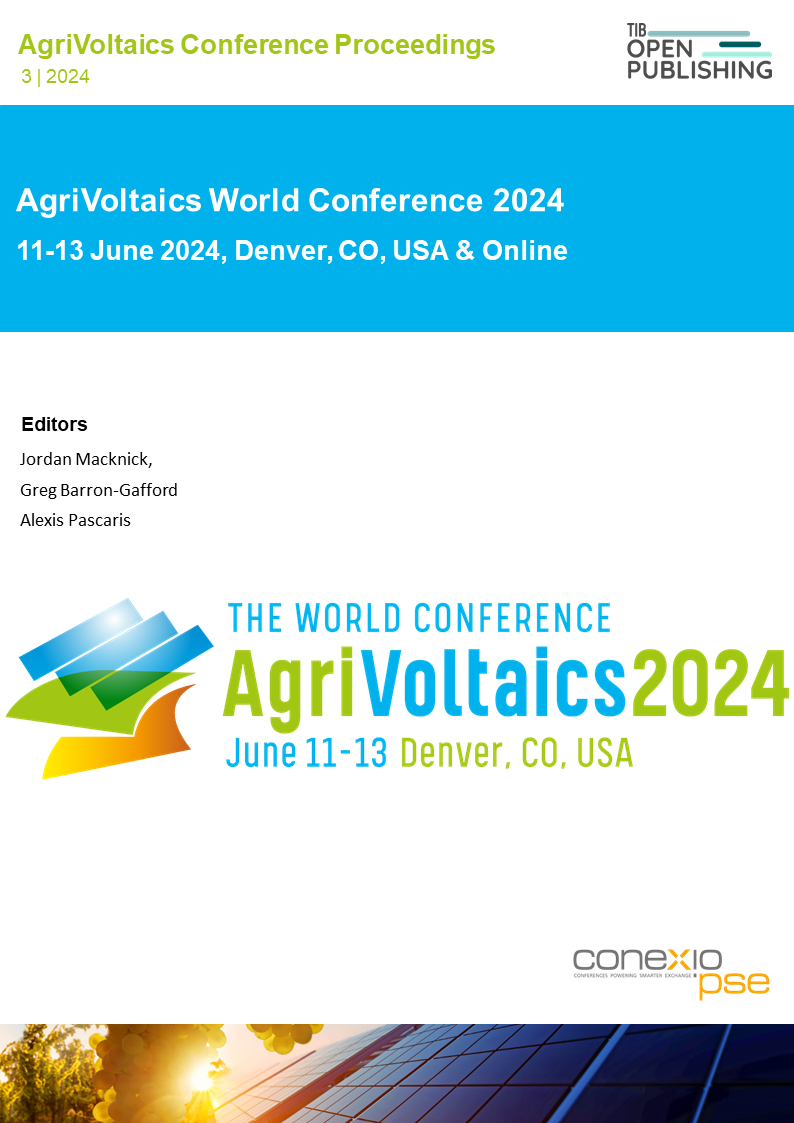A Comprehensive Life Cycle Assessment Framework for Agrivoltaic Systems
DOI:
https://doi.org/10.52825/agripv.v3i.1396Keywords:
Agrivoltaics, Life Cycle Assessment, Food-Energy-Water Nexus, Multiple Land UseAbstract
This paper suggests a comprehensive life cycle assessment (LCA) framework for agrivoltaic systems - systems that integrate photovoltaic energy and agricultural production. Agrivoltaics proposes a solution that provides additional land for meeting renewable energy goals while supporting agricultural production and water and land use efficiency. This study contributes to the assessment of the dynamic life cycle improvements associated with agrivoltaics installations through applying the framework to a case study at Jack's Solar Garden in Boulder, Colorado. We utilize the ReCIPe midpoint hierarchist method and leverage data from existing OpenLCA databases to evaluate the environmental and economic impacts of co-located crop production and solar energy generation. The results highlight the potential for reduced land and water use, underscoring agrivoltaics' role in managing land conflicts and water scarce environments. However, challenges such as increased material demands, limited open-source data, and the need for tailored configurations remain. Our framework aims to guide researchers, producers, and policymakers in making informed decisions on the adoption of agrivoltaics.
Downloads
References
H. Dinesh and J. M. Pearce, "The potential of agrivoltaic systems," Renewable and Sus-tainable Energy Reviews, vol. 54, pp. 299-308, 2016, doi: 10.1016/j.rser.2015.10.024.
G. A. Barron-Gafford, M. A. Pavao-Zuckerman, R. L. Minor, L. F. Sutter, I. Barnett-Moreno, D. T. Blackett, M. Thompson, K. Dimond, A. K. Gerlak, G. P. Nabhan, and J. E. Macknick, "Agrivoltaics provide mutual benefits across the food–energy–water nexus in drylands," Nature Sustainability, vol. 2, pp. 848-855, 2019, doi: 10.1038/s41893-019-0364-5.
Y. Elamri, B. Cheviron, J. M. Lopez, C. Dejean, and G. Belaud, "Water budget and crop modelling for agrivoltaic systems: Application to irrigated lettuces," Agricultural Water Management, vol. 208, pp. 440-453, 2018, doi: 10.1016/j.agwat.2018.07.001.
S. Touil, A. Richa, M. Fizir, and B. Bingwa, "Shading effect of photovoltaic panels on hor-ticulture crops production: A mini review," Reviews in Environmental Science and Bio/Technology, vol. 20, pp. 281-296, 2021, doi: 10.1007/s11157-020-09537-x.
R. Handler and J. M. Pearce, "Greener sheep: Life cycle analysis of integrated sheep agrivoltaic systems," Cleaner Energy Systems, vol. 3, p. 100036, 2022, doi: 10.1016/j.cles.2022.100036
A. S. Pascaris, R. Handler, C. Schelly, and J. M. Pearce, "Life cycle assessment of pas-ture-based agrivoltaic systems: Emissions and energy use of integrated rabbit produc-tion," Cleaner and Responsible Consumption, vol. 3, p. 100030, 2021, doi: 10.1016/j.clrc.2021.100030.
C. Busch and K. Wydra, “Life cycle assessment of an agrivoltaic system with conven-tional potato production,” Journal of Renewable and Sustainable Energy, vol. 15, no. 4, p. 043501, Jul. 2023, doi: 10.1063/5.0156779.
A. Agostini, M. Colauzzi, and S. Amaducci, “Innovative agrivoltaic systems to produce sustainable energy: An economic and environmental assessment,” Applied Energy, vol. 281, p. 116102, Jan. 2021, doi: 10.1016/j.apenergy.2020.116102.
A. Leon and K. N. Ishihara, “Assessment of new functional units for agrivoltaic systems,” Journal of Environmental Management, vol. 226, pp. 493–498, Nov. 2018, doi: 10.1016/j.jenvman.2018.08.013.
T. J. Dijkman, C. Basset-Mens, A. Antón, and M. Núñez, “LCA of Food and Agriculture,” in Life Cycle Assessment, M. Z. Hauschild, R. K. Rosenbaum, and S. I. Olsen, Eds., Cham: Springer International Publishing, 2018, pp. 723–754. doi: 10.1007/978-3-319-56475-3_29.
S. Fisher and A. Karunanithi, "Contemporary comparative LCA of commercial farming and urban agriculture for selected fresh vegetables consumed in Denver, Colorado," in Proc. 9th Int. Conf. Life Cycle Assessment Agri-Food Sector, San Francisco, CA, 2014, pp. 405-414.
T. Swanson, C. Seay-Fleming, A. K. Gerlak, and G. A. Barron-Gafford, “'Enough is enough, we like our farms': The role of landscape ideology in shaping perceptions of solar energy and agrivoltaics in the rural American Southwest," Journal of Rural Studies, vol. 114, Feb. 2025, Art. no. 103572.
R. K. Chopdar, N. Sengar, N. C. Giri, and D. Halliday, "Comprehensive review on agri-voltaics with technical, environmental and societal insights," Renewable and Sustainable Energy Reviews, vol. 197, Jun. 2024, Art. no. 114416.
A. S. Pascaris, C. Schelly, L. Burnham, and J. M. Pearce, "Integrating solar energy with agriculture: Industry perspectives on the market, community, and socio-political dimen-sions of agrivoltaics," Energy Research & Social Science, vol. 75, May 2021, Art. no. 102023.
GreenDelta, "OpenLCA v2.1.1," GreenDelta, 2020. [Software]. Available: https://www.openlca.org
M. Goedkoop, R. Heijungs, M. Huijbregts, A. De Schryver, J. Struijs, and R. Van Zelm, "ReCIPe 2008, A Life Cycle Impact Assessment Method Which Comprises Harmonised Category Indicators at the Midpoint and the Endpoint Level," First edition (version 1.08), 2009. [Online]. Available: https://www.rivm.nl/documenten/recipe-2008-manual
F. Hosseini-Fashami, A. Motevali, A. Nabavi-Pelesaraei, S. J. Hashemi, and K. Chau, “Energy-Life cycle assessment on applying solar technologies for greenhouse strawber-ry production,” Renewable and Sustainable Energy Reviews, vol. 116, p. 109411, Dec. 2019, doi: 10.1016/j.rser.2019.109411
Ecoinvent Centre, "Ecoinvent v3.4," Ecoinvent, 2017. [Database]. Available: https://www.ecoinvent.org
ADEME, "Agribalyse v3.0.1," ADEME, 2020. [Database]. Available: https://www.ademe.fr
Bloom, D. E., Choi, C. S., Li, Y., Macknick, J., McCall, J., and Ravi, S., “Interactions between solar photovoltaic arrays and the underlying soil-vegetation system”, vol. 2019, Art. no. B21F-2386, 2019
Published
How to Cite
Conference Proceedings Volume
Section
License
Copyright (c) 2025 Katelyn Whiting, Steven Conrad, Thomas Bradley, Tim Coburn

This work is licensed under a Creative Commons Attribution 4.0 International License.
Accepted 2025-03-31
Published 2025-08-08
